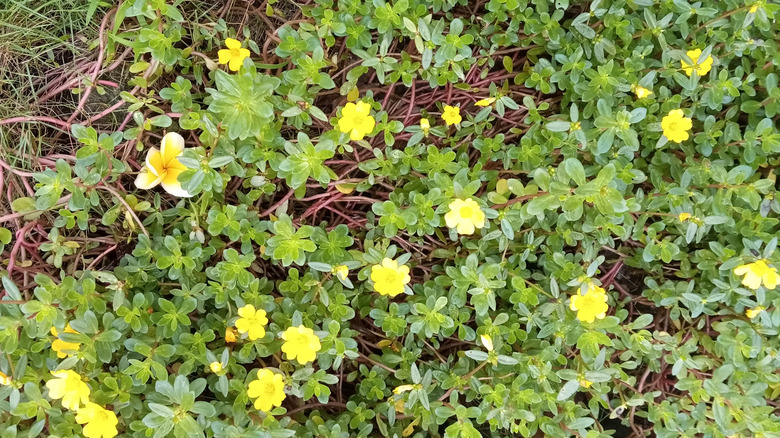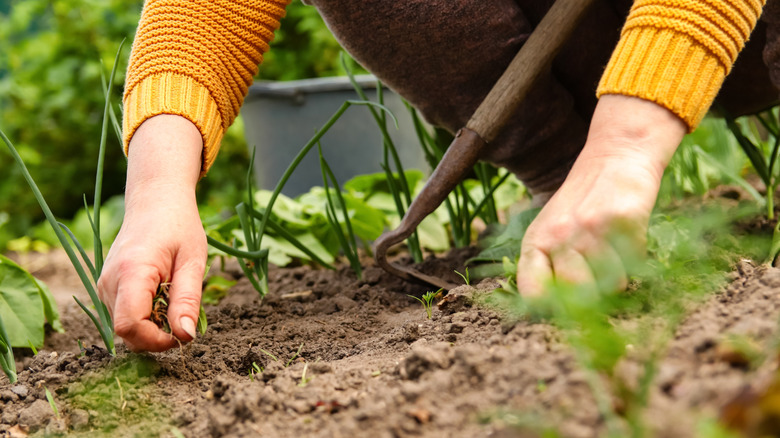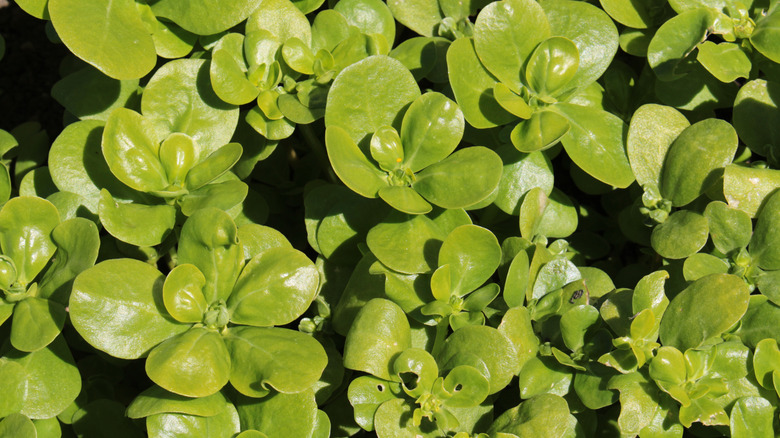How To Keep This Common Weed Out Of Your Garden Forever
Purslane (Portulaca oleracea) might seem harmless with its small yellow flowers, but this aggressive annual weed can quickly overtake garden beds and lawns if left unchecked. Sometimes mistaken for beneficial groundcover, purslane spreads incredibly fast. A single plant can produce more than 240,000 seeds that can infect your soil for up to 40 years. Its stems store water, allowing it to survive droughts that would kill other weeds. Even broken stems can re-root themselves into your lawn, creating a cycle that is hard to break. There is also a poisonous purslane look-alike called spurge that requires a different removal approach, so make sure you have verified which plant you'll be dealing with before starting. Luckily, there are ways to take care of the problem. With a little hand-pulling, herbicides, or a complete plastic covering, these little yellow weeds can be a thing of the past.
Keeping them away will take more persistence though, as purslane can survive in poor soil conditions where other plants struggle, often popping up in sidewalk cracks, gardens, and between patio stones. Purslane will not only fight with your other garden plants for space but will also steal precious nutrients. It grows like a blanket over your soil, smothering seedlings, or smaller plants. The weed also has a deep taproot, which makes hand-pulling more difficult. Its rapid growth cycle in the late spring means a quick infestation that may get out of control before you have time to realize it's happening. Proper lawn care and soil maintenance will help curb these infestations, but you will need to be vigilant.
How to get rid of purslane without harming your garden
Getting rid of weeds in your garden is hard enough, but to properly get rid of purslane, you'll need a plan. For a small infestation, hand-pulling can be helpful if done carefully. Make sure you remove the entire root system while the ground is wet, and do not leave anything behind, as these small bits can quickly re-root. Heating your soil through solarization works well for large areas. Simply cover the entire infestation with clear plastic for four to six weeks during hot weather. The sun's heat, combined with the smothering plastic, will kill both the plant and its seeds. This is less effective in areas with plants you wish to keep though, as it will smother them all.
It really comes down to timing when working against purslane. Herbicides applied in early spring can help prevent seed germination, while after-growth treatments work best on young buds before they develop deep roots. For organic gardens, corn gluten meal added before the plant's bud can help reduce germination rates. Whatever method you decide to go with, persistence and consistency are important. Purslane's seed production is aggressive, which means even a few overlooked areas can restart the entire infestation. Also, be sure to clean your tools after working so you do not spread leftover bits into other weed-free areas.
Keeping purslane from returning
Once cleared out, keeping purslane away from your garden requires both adjustments to the environment as well as good maintenance habits. Keep your good plants dense, leaving no bare soil for weeds to infiltrate. Positive ground cover plants like creeping thyme or mulch layers around 3 to 4 inches deep will help block sunlight from reaching leftover purslane seeds. Improving your soil's structure will help as well. If your lawn is full of compacted soil, purslane will have a much easier time thriving than other non-weed species. Consider adding more organic matter to your soil, like mulch or compost. If you are trying to fight purslane in a vegetable garden, landscape fabric with specific planting holes can help. Despite some downsides to using landscape fabric, these coverings will help prevent seed germination while still allowing your crops to grow.
The best thing to do when fighting purslane is to stay vigilant. Look for the weed weekly during growing seasons and remove it as soon as possible. This helps catch the problem before it can take root. If you can, keep a "weed diary" to track infestation patterns, noting areas that need extra attention. Combining all these methods is helpful if it seems like you just cannot get a handle on the problem. Use the herbicides in early spring and keep consistent with hand-pulling throughout the summer. Purslane seeds can also be introduced through contaminated compost or mulch, so make sure you source these materials from reputable suppliers to avoid accidentally reintroducing the weed you've worked so hard to remove.


